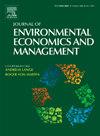高温下的劳动力再分配:孟加拉国农村地区的综合分析
IF 5.9
3区 经济学
Q1 BUSINESS
Journal of Environmental Economics and Management
Pub Date : 2025-09-09
DOI:10.1016/j.jeem.2025.103199
引用次数: 0
摘要
本文考察了极端高温对孟加拉国农村工作年龄成年男性劳动力部门再分配的影响,使用了三个时期的个人就业面板。研究表明,高温促使劳动力从非农业部门转向农业部门,主要是农业领薪工作。农业部门就业选择的差异取决于家庭土地所有权。拥有更多土地的家庭中的个人倾向于从事作物种植,而拥有很少或没有土地的家庭中的个人更有可能为工资而工作。两个关键渠道解释了极端高温如何影响就业。首先,极端高温增加了对雇佣农业劳动力的需求,尤其是在农忙季节,因为劳动力流失可能导致作物歉收。其次,当地需求效应变得明显,因为高温降低了家庭总收入,提高了食品价格,并将支出转向食品,导致非农业部门收缩。本文章由计算机程序翻译,如有差异,请以英文原文为准。
Labor reallocation in the heat: A comprehensive analysis in rural Bangladesh
This paper examines the impact of extreme heat on the sectoral reallocation of working-age adult male labor in rural Bangladesh using a three-period panel on individual employment. It shows that high temperatures prompt a labor shift from the non-agricultural to agricultural sectors, primarily into agricultural wage jobs. Variations in employment choices in the agricultural sector depend on household land ownership. Individuals in households with more land tend to engage in crop cultivation, whereas individuals in households with little or no land are more likely to work for wages. Two key channels explain how extreme heat influences employment. First, extreme heat raises demand for hired agricultural labor, especially during busy farming seasons, as labor loss risks crop failure. Second, local demand effects become evident as higher temperatures reduce overall household income, raise food prices, and shift spending towards food, causing the non-agricultural sector to contract.
求助全文
通过发布文献求助,成功后即可免费获取论文全文。
去求助
来源期刊
CiteScore
8.00
自引率
4.30%
发文量
91
期刊介绍:
The Journal of Environmental Economics and Management publishes theoretical and empirical papers devoted to specific natural resources and environmental issues. For consideration, papers should (1) contain a substantial element embodying the linkage between economic systems and environmental and natural resources systems or (2) be of substantial importance in understanding the management and/or social control of the economy in its relations with the natural environment. Although the general orientation of the journal is toward economics, interdisciplinary papers by researchers in other fields of interest to resource and environmental economists will be welcomed.

 求助内容:
求助内容: 应助结果提醒方式:
应助结果提醒方式:


